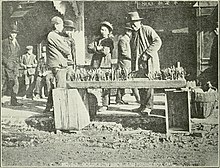Cantonese people
The Hakka and Min-speaking people (such as Hoklo, Teochew and Leizhounese) who also reside in Guangdong are usually differentiated from the Cantonese as they speak non-Yue Chinese languages.
[10][12] Within Guangdong and Guangxi, Cantonese is considered the prestige dialect and is called baahk wá, [pàːk wǎː] (白話) which means "vernacular".
Cantonese peoples are predominantly of Han Chinese ancestry, with various local genetic clusters suggesting regional language-based endogamy.
[13][14][15] They descend from Han migrants from the Central Plains, who continually migrated to southern China and in the process, absorbed Tai-speaking (or Bai Yue) minorities in their community.
[22] Because of their native southern ancestry, they slightly differ from other Han subgroups in skin tone, build, stature and having a higher incidence of certain diseases such as nasopharyngeal cancer.
[23] Despite being a distinct sub-group among Guangdong Han, Cantonese show less genetic differences with Teochew and Hakka people due to population assimilation and gene flow.
[27] The first Chinese presence in Guangdong can be traced to the conquest by the Qin general Zhao Tuo and his subsequent establishment of the Nanyue kingdom, a hybrid Han-Yue polity as an independent state.
[30] Following the collapse of central authority in the Qin Empire, the Han Chinese soldiers, conscripts, and laborers under Zhao Tuo's command were incorporated into the Nanyue kingdom[35] and ordered to mix with the local inhabitants.
Like the founder Zhao Tuo, the aristocratic elite and military class of the newly formed Nanyue state were of Central Plains origin and mediated the transmission of Han culture to the local inhabitants.
Buildings began to feature architectural elements from the Central Plains, including covered galleries, drains, stone lintels, and columnar bases.
[36] The Han aristocratic elite, however, did adopt features of the Bai Yue culture, including the use of feathered headdresses as represented on Nanyue cauldrons, in order to bolster their authority amongst the indigenous people in the new hybrid Han-Yue polity.
[41] Waves of migration and intermarriage meant that the indigenous populations of both Guangxi and Guangdong provinces were either assimilated or displaced, but some native groups like the Zhuangs remain.
This is because Han immigration and the intermarriage with and acculturation of indigenous tribes reached a critical mass during the Tang dynasty, creating a new local identity among the Liangguang peoples.
[45] Unlike the migrants from Fujian, who mostly settled in Southeast Asia, many Cantonese emigrants also migrated to the Western Hemisphere, particularly the United States, Canada, Australia and New Zealand and Burma.
The Taishanese variant is still spoken in American Chinese communities, by the older population as well as by more recent immigrants from Taishan, in Jiangmen, Guangdong.
[54] Operating from the Thirteen Factories located on the banks of the Pearl River outside Canton, merchants traded goods such as silk, porcelain ("fine china") and tea, allowing Guangzhou to become a prosperous city.
[55] Hong Kong and Macau are two of the richest cities in the world in terms of GDP per capita and are autonomous SARs (Special Administrative Regions) that are under independent governance from China.
Historically governed by the British and Portuguese empires respectively, colonial Hong Kong and Macau were increasingly populated by migrant influxes from mainland China, particularly the nearby Guangdong Province.
For that reason, the culture of Hong Kong and Macau became a mixture of Cantonese and Western influences, sometimes described as "East meets West".
The term "Cantonese" is used to refer to the native culture, language, and people who can trace their ancestral roots back to the city of Guangzhou.
[60] Though in recent years it is slowly falling out of favour with the younger generation [61] prompting fears in Cantonese people that the language may die out.
[62] Written Cantonese is very common in manhua, books, articles, magazines, newspapers, online chat, instant messaging, internet blogs and social networking websites.
Some videogames such as Sleeping Dogs, Far Cry 4, Grand Theft Auto III and Resident Evil 6 have substantial Cantonese dialogues.
[64] One of the most famous examples of Cantonese cuisine is dim sum, a variety of small and light dishes such as har gow (steamed shrimp dumplings), siu mai (steamed pork dumplings) and cha siu bao (barbecued pork buns).This is an incomplete list of notable Cantonese people.










